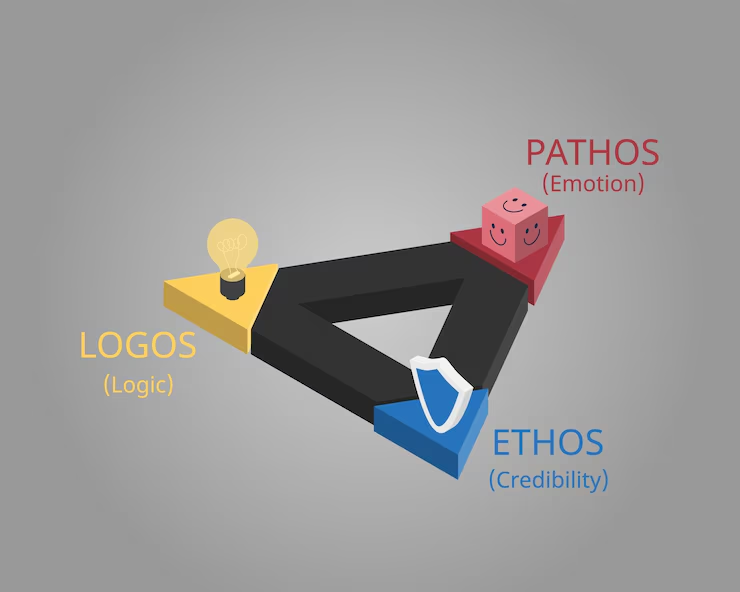From marketing to academia, the importance of writing is paramount. Among the different styles of writing, persuasive writing is the most commonly used form. From drafting assignments to convincing ad copies, persuasive writing is widely used by all. If you take a closer look at this writing style, you will find three foundational techniques, namely, ethos, pathos, and logos. Now, how do they get used in an essay? This blog has the answers to all these questions.
If you hire a professional persuasive essay writer, they will suggest you to use three elements while writing a persuasive essay.
| Name of the Functional Techniques | What it Serves |
| Ethos | Establishes Credibility |
| Pathos | Engages Emotions |
| Logos | Crafts Logical Arguments |
Ethos
If you take online essay writing help from trusted sites like MyAssignmenthelp.com, you will learn that ethos refers to the credibility of the writer. It shows your audience that you are –
- Trustworthy
- Knowledgeable
- Ethical
Ethos can be established in several ways –
1. Demonstrating Expertise
This involves citing –
- Relevant Qualifications
- Experiences
- Credentials
Including these details helps to establish authority over the readers.
2. Displaying Integrity
When you are honest in your writing, it promotes trust. Acknowledging counterarguments helps to reinforce your ethical stance.
3. Using Reliable Sources
Citing reputable sources bolsters your credibility. When you support your arguments with credible information, your audience is more likely to accept your viewpoint.
4. Connecting with Values
Aligning your message with the audience’s values or ethical beliefs strengthens your ethos. If your audience values sustainability, framing your argument around environmental ethics can enhance your appeal.
Pathos
Pathos evoke the various emotions of the audience. Here are some of the emotions that might get triggered by pathos –
- Sympathy
- Anger
- Joy
- Fear
This is how you can incorporate pathos into your persuasive writing –
1. Using Vivid Imagery
Descriptive language that paints a picture can evoke emotional responses. Instead of stating facts, illustrate scenarios that resonate on a personal level. For example, discussing the plight of endangered animals can stir empathy and concern.
2. Sharing Personal Stories
Anecdotes or personal experiences can humanize your argument. When you share a personal narrative, you lead the audience to empathize with your situation.
3. Appealing to Values
Tap into core human values like –
- Justice
- Family
- Freedom
By aligning your argument with these universal values, you can evoke a stronger emotional response.
4. Utilizing Rhetorical Questions
Ask questions that lead your audience to emotionally engage with your topic. For example, you can ask, “How would you feel if rising sea levels threatened your home?”
Pathos is powerful because it transcends logic. This helps individuals learn the importance of emotional responses rather than only rational arguments.
Logos
Logos refers to the logical appeal of your argument. It involves using –
- Reason
- Facts
- Evidence
A well-structured logical argument can effectively support your claims. Here’s how to enhance logos in your writing:
1. Presenting Data and Statistics
Try to incorporate these elements in your argument –
- Numerical data
- Statistics
- Factual information
2. Using Logical Structure
Organize your arguments in a clear and logical manner. Always start with a strong thesis statement. Follow it up with supporting points and build on that evidence. A logical structure guides the audience through your reasoning.
3. Employing Analogies and Comparisons
Analogies can clarify complex ideas easily. It simplifies the complex terms by relating them to familiar concepts. For example, you can compare the growth of the internet to the Industrial Revolution. Then, you can take both examples to illustrate the impact of technology on society.
4. Addressing Counterarguments
Acknowledging opposing viewpoints is essential in a persuasive essay. You can also refute them as needed to demonstrate your position. When you address counterarguments, it shows that you have thought about it from multiple angles. This enhances the logical appeal of your argument.
When students look to pay for assignments, it becomes essential to ensure that the work they receive is logically sound and well-structured. Logos are essential for rational discourse, providing the backbone for your persuasive writing. When you combine ethos and pathos with it, it only enhances the depth of your arguments.
The Interplay of Ethos, Pathos, and Logos
| Types of Elements | How to Use |
| Ethos | Start by establishing your credibility as a researcher |
| Pathos | Share a compelling story about the community impacted by a specific reason |
| Logos | present statistics on the relevant reason and establish why you are right |
For example, if you are writing about renewable energy, you can follow these steps –
- Start by establishing your credibility as a researcher
- Then, share a compelling story about a community impacted by pollution
- Present statistics on the benefits of renewable sources compared to fossil fuels
It is important for any student to master the art of persuasion. So, learning ethos, pathos, and logos is crucial for effective communication. Here, we have discussed all the steps that can help you write top-notch persuasive papers. So, whether you are writing an essay or a marketing campaign, use these techniques diligently to write the perfect persuasive essay.

